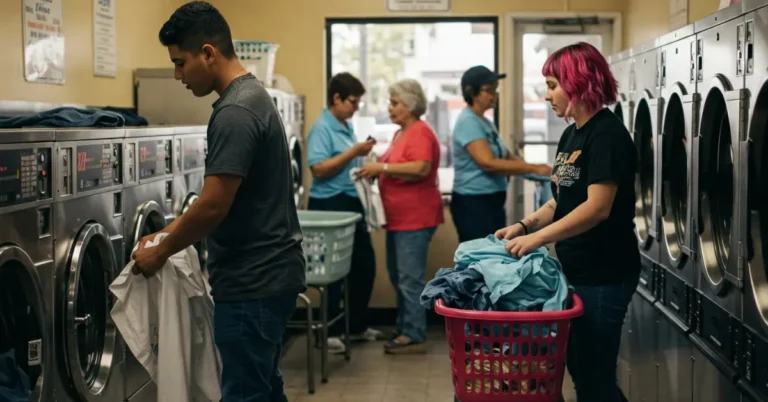How Much Laundry Does a Single Person Generate? Laundry Tips for Singles
Laundry. It’s a never-ending cycle, a chore that seems to multiply overnight. But how much laundry does a single person generate? It’s a question that many individuals ponder as they stare at their overflowing hampers, wondering if their laundry habits are “normal.”
In this comprehensive guide, we’ll dive deep into the world of single-person laundry. We’ll explore the laundry statistics, various factors that influence laundry generation, dissect the average laundry load for singles, and offer practical tips for managing your clothes cleaning efficiently and sustainably. Whether you’re a laundry novice or a seasoned pro, this article will equip you with the knowledge and tools to conquer your clothes cleaning routine.
Surprising Laundry Stats!
Did you know that families wash a HUGE amount of laundry every year? It’s like climbing Mount Everest… made of socks and t-shirts! They wash about 6,000 pieces of clothing, which is like washing every single thing you own, and then doing it again and again!
Laundry is something we do so often that we don’t even think about it, like washing the dishes or brushing our teeth. Have you ever wondered how much laundry a single person creates? According to a survey conducted by Mulberry’s asking over 2000 Americans about their laundry habits.
Some answers were normal, but some were surprising! You know what’s surprising? Not everyone washes their underwear! Some people in the survey said they don’t wash their underwear at all! Maybe they were just joking, though.
Some of the Interesting findings of the survey are:
- Most folks spend less than $50 each month on dry cleaning
- A small number of people spend up to $150 each month laundering their clothes
- Girls seem to start doing laundry earlier than boys.
Factors Affecting Laundry Generation

The amount of laundry a single person generates can vary significantly depending on several factors. Understanding these factors can help you better estimate your laundry load and adjust your washing habits accordingly.
1. Lifestyle
Your lifestyle plays a crucial role in determining how much laundry you generate.
- Activity Level: If you lead an active lifestyle, you’ll likely generate more laundry than someone who is more sedentary. Regular exercise, outdoor activities, and hobbies can all contribute to a larger laundry pile.
- Social Life: Do you frequently go out to restaurants, bars, or social events? If so, you’ll probably need to wash your clothes more often than someone who stays home more often.
- Travel: If you travel frequently, you’ll likely generate less laundry at home, but you’ll still need to do laundry while you’re away.
2. Work
Your occupation can also influence your laundry generation.
- Dress Code: If your job requires you to wear a uniform or adhere to a strict dress code, you may generate more laundry than someone with a more casual dress code.
- Physical Labor: If your job involves physical labor, you’ll likely sweat more and need to wash your clothes more frequently.
- Work Environment: If you work in a dirty or dusty environment, your clothes may require more frequent washing.
3. Season
- Summer: Hot and humid weather can lead to increased perspiration, requiring more frequent washing of clothes.
- Winter: Layering clothes for warmth can result in a larger laundry load. Additionally, winter weather can bring snow, slush, and salt, which can soil clothes more quickly.
4. Personal Habits
Your personal habits and preferences also play a role in laundry generation.
- Cleanliness Standards: How often do you like to change your clothes? Some people prefer to wear clothes multiple times before washing, while others prefer to wash clothes after each use.
- Laundry Practices: Do you sort your laundry carefully? Do you wash full loads? Your laundry practices can affect how often you need to do laundry.
5. Health
Certain health conditions can affect laundry generation.
- Allergies: If you have allergies, you may need to wash your clothes more frequently to remove allergens.
- Incontinence: Incontinence can also lead to increased laundry generation.
Dissecting the Average Laundry Load for Singles
While laundry generation can vary widely, it’s helpful to have a general idea of what the average single person might generate. Based on the analysis of competitor articles and general laundry guidelines, here’s an estimated breakdown of a weekly laundry load for a single person:
Clothing:
- Underwear: 7-14 pairs
- Socks: 7-14 pairs
- Shirts/blouses: 7-14
- T-shirts: 7-14
- Jeans: 1-2 pairs
- Pants/skirts/dresses: 3-4
- Sweaters: 1-2
- Workout clothes: 3 sets
- Sleepwear: 2-3 sets
- Outerwear: 1-2 pieces (seasonal)
Linens:
- Bath towels: 2-5
- Washcloths: 7
- Hand towels: 1-4
- Bath mats: 1-2
- Kitchen towels: 1-3
- Kitchen washcloths: 2-3
- Kitchen mat: 1
- Pillowcases: 2-3
- Flat sheets: 1-2
- Blanket/duvet/comforter: 1 (monthly)
Important Considerations:
- This is just an estimated average. Your actual laundry load may be higher or lower depending on the factors discussed earlier. The frequency of washing certain items can vary. For example, some people wash their jeans after every wear, while others wash them every few wears.
- The frequency of washing certain items can vary. For example, some people wash their jeans after every wear, while others wash them every few wears
- Consider your lifestyle, work, season, personal habits, and health when estimating your laundry load.
Tips for Managing Your Laundry
1. Sort Your Laundry Like a Pro
Proper sorting is the foundation of effective laundry management. Separate your clothes into different categories based on color, fabric type, and washing instructions. This will help prevent color bleeding, protect delicate fabrics, and ensure that your clothes are washed at the correct temperature.
2. Embrace the Power of Full Loads
Washing full loads is one of the most effective ways to save water and energy. However, avoid overloading your washing machine, as this can damage your clothes and reduce the effectiveness of the wash.
3. Choose the Right Detergent
Selecting the right detergent is crucial for achieving clean and fresh laundry. Consider factors such as your washing machine type, water hardness, and the types of fabrics you wash. Look for high-efficiency detergents that are formulated to work effectively in low water temperatures.
4. Master the Art of Cycle Selection
Most washing machines offer a variety of cycles designed for different types of fabrics and soil levels. Consult the care labels on your clothes and choose the cycle that best suits their needs. Using the correct cycle will help protect your clothes and ensure they are cleaned thoroughly.
5. Dry Your Clothes with Care
Drying your clothes properly is essential for preventing damage and extending their lifespan. Line drying is the most environmentally friendly option, but it may not always be feasible. If you use a tumble dryer, choose a low heat setting and avoid over-drying your clothes.
6. Wash Less Often
Not all clothes need to be washed after every wear. Items like jeans, sweaters, and jackets can often be worn multiple times before they require washing. Washing clothes less often can save water, energy, and reduce wear and tear on your clothes.
8. Embrace Sustainable Laundry Practices
Consider incorporating sustainable laundry practices into your routine. This includes using eco-friendly detergents, washing clothes in cold water, and line drying whenever possible.
9. Time Management
Laundry can be time-consuming, but there are ways to streamline the process. Consider setting aside a specific time each week for laundry, and break down the task into smaller, more manageable chunks.
10. Seek Professional Help
If you’re struggling to keep up with your laundry, consider seeking professional help. Many laundry services offer wash-and-fold or dry-cleaning services, which can free up your time and reduce stress.
Wrapping Up How Much Laundry Does a Single Person Generate?
The amount of laundry a single person generates can vary based on lifestyle, work, season, personal habits, and health. However, the estimated list above provides a good starting point for understanding laundry generation. By following the tips provided, single people can effectively manage their laundry while minimizing their environmental impact.
FAQ’S on How Much Laundry Does a Single Person Generate?
How much laundry does the average single person do?
The average single person generates roughly 1-2 loads of laundry per week, but this can vary based on lifestyle, occupation, and personal habits.
What factors affect how much laundry a single person generates?
Factors like activity level, occupation, season, personal hygiene habits, and health conditions can all influence laundry generation
How can I reduce the amount of laundry I generate?
You can reduce your laundry pile by wearing clothes more than once between washes (when appropriate), choosing durable clothing, and adopting sustainable laundry practices.
How often should a single person wash their sheets and towels?
Sheets should generally be washed once a week, while towels can be washed after 3-4 uses.
Does the type of fabric affect how often I need to do laundry?
Yes, natural fabrics like bamboo, hemp, and organic cotton tend to be more breathable and require less frequent washing.








2 Comments